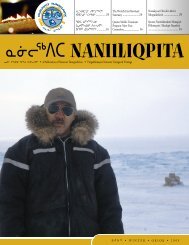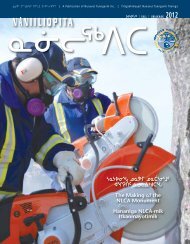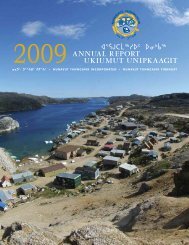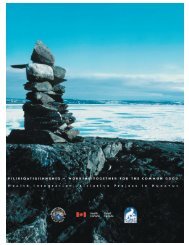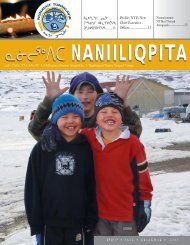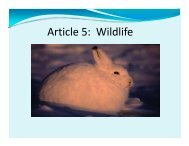Ensuring a Sustainable and Humane Seal Harvest - Nunavut ...
Ensuring a Sustainable and Humane Seal Harvest - Nunavut ...
Ensuring a Sustainable and Humane Seal Harvest - Nunavut ...
Create successful ePaper yourself
Turn your PDF publications into a flip-book with our unique Google optimized e-Paper software.
Working Group on the Canadian Harp <strong>Seal</strong> Hunt, as well as a group of Canadianveterinarians who, in a peer-reviewed scientific study published in 2002, came to theconclusion that “the large majority of seals taken during this hunt (at best, 98% in workreported here) are killed in an acceptably humane manner.” 35In October 2006, the Committee met with two representatives of the IndependentVeterinarians’ Working Group on the Canadian Harp <strong>Seal</strong> Hunt. Dr. Alice Crook, one of thetwo expert witnesses, expressed concerns that the veterinarians involved in the 2001IFAW sponsored study did not have the relevant expertise or use appropriate methods todetermine the condition of the animals. She noted:[T]his group of five veterinarians who came together only very briefly <strong>and</strong> were on the icefor two days. They produced the report as a result of those two days, plus the viewing ofvideotapes — many of which were the same ones we viewed. Another difference is thatno one in their group was a veterinary pathologist. When they examined skulls, theydidn’t have the facilities to take them back to a lab, take them apart, <strong>and</strong> look for braininjuries. 36Dr. Alice Crook <strong>and</strong> Dr. Charles Caraguel also addressed the issue of the swimmingreflex, which to an uninformed observer, may be construed as a voluntary movement of aconscious animal. The swimming reflex is in fact an involuntary movement characterizedby vigorous lateral movements of the hind end of the animal. This movement would be“equivalent to the paddling movements of livestock that would be seen in an abattoir whenthe animal’s been hit with a stun gun.” 37 Expert witnesses told the Committee that they hadshown after a careful examination of animals examined on site that the swimming reflexwas a medullar reflex <strong>and</strong> not a cerebral reflex, <strong>and</strong> was therefore independent of brainintegrity. For marine animals, the swimming reflex can last longer than for terrestrialanimals. The duration of the swimming reflex is on average nine seconds, ranging from 2to 35 seconds. The IFAW sponsored report had “assumed that all movement seen couldbe due to conscious voluntary muscle activity” because of the difficulty “to differentiatebetween involuntary reflex movement <strong>and</strong> conscious voluntary movement withoutassessing higher centre activity.” 38More importantly, the two expert witnesses testified that the methods used to killseals — the hakapik <strong>and</strong> the rifle — which are regulated by the federal government <strong>and</strong>which have been studied extensively by independent experts, satisfy both the35 P.-Y. Daoust, A. Crook, T. K. Bollinger, K. G. Campbell, J. Wong, “Animal welfare <strong>and</strong> the harp seal hunt in AtlanticCanada,” Canadian Veterinary Journal, September 2002, p. 687.36 Alice Crook, Committee Evidence, October 5, 2006.3738Ibid.International Fund for Animal Welfare, 2001.15




